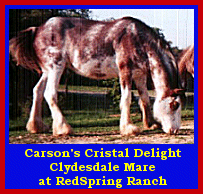Avg Height: 16.2 to 18 hh
Avg Weight: 1600 to 2000 lbs
*~The largest Clydesdale on record was 21 hh and 2600 lbs~*
Temperament: They are good natured gentle for their large size, and they enjoy interacting with people.
Special abilities: For its size the Clydesdale is an exceptionally active animal, and this, together with its strength, stamina, and amenable disposition, have made it popular in many parts of the world.

For Breeders, Farms, and Studs of this breed, click here.
If you have a horse of this breed, and you would like to see your pictures posted here, or if you would like to advertise your business that involves this particular breed, you can also email me.
I'm not perfect, and I never claim to be! If you see anything here that you believe I am wrong about, please feel free to email me. I might not agree with you, but at least I will listen!! :0) Can you fill in any of my blanks? Do you know of information or links that you would like to share with draft animal enthusiasts that you don't see here? Am I missing anything? Let me know at Draftladyb@yahoo.com.